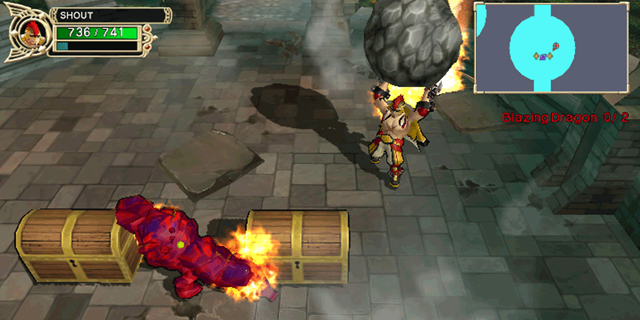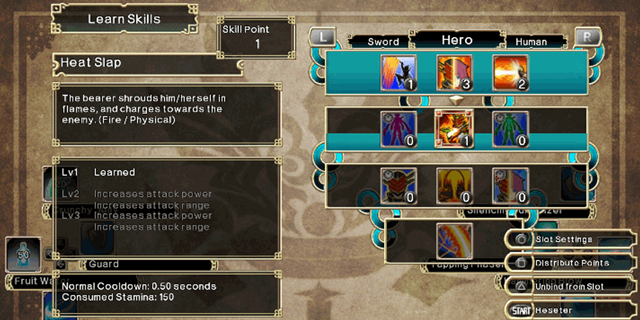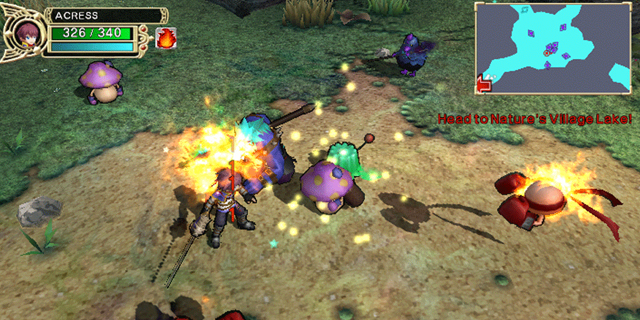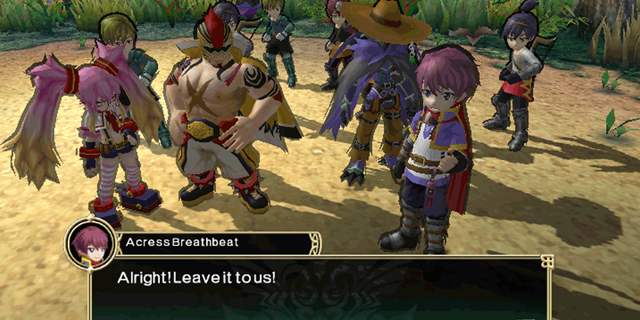
Fantasy Hero: Unsigned Legacy achieves the gameplay goals that it sets out to hit quite well. It functions as a straight dungeon crawl, with individual quest runs broken up into bite-sized five-to-15-minute chunks. It isn’t the most interesting game, and it doesn’t really push the envelope in any new ways, but it is fun and it is designed well for portable play. If you enjoy short dungeon runs, beating up bad guys and collecting loot, then you should seriously consider Fantasy Hero.
The gameplay loop of Fantasy Hero is simple but addictive. In the world’s main hub, you have the option of customizing your character (through appearance, equipment, abilities and stats), visiting a shop, or undertaking a quest from the town’s message board. After accepting a quest (either in the main quest line or a side quest), a door opens and you head out to run the dungeon (or area) that the quest sends you where you battle monsters and complete the given objective. These quests are typically short (most under ten minutes) and they have a variety of objectives, but they typically boil down to running around an area defeating monsters and collecting loot. Many of the areas are actually repeated for different quests with just some positioning of the chests and traps shifted around, but they’re short enough that this actually isn’t too noticeable a problem.

You spend most of your time in Fantasy Hero in the combat system, which proves to be no-frills but fun. Each of the different playable characters gets a weapon with both primary and secondary attacks. At its most basic level, combat revolves around appropriately mashing these two buttons while running around and dodging various attacks. There is a bit more strategy here as you prioritize which enemies to attack first and learn to “bait” some enemies into attacking first making them vulnerable, but these are only minor additions to the formula. You are able to assign skill points into various abilities as you level and these can help vary the flow of combat as you integrate these into your rotation, but this is as complex as it gets. There is no combo or chain system here, and over longer play sessions, this can get very repetitive. This system actually benefits shorter play chunks, however, as it’s very easy to pick up and play, even if you haven’t played for a while.
One really nice feature implemented in Fantasy Hero is the option to choose the difficulty of each quest when you accept it. The quests always give a recommended level, but then you can increase the difficulty rating to make it more challenging to match your character’s power. Generally, the game isn’t overly challenging on the default difficulty setting, and I found that, as long as I did the available side quests as they popped up, my experience level was almost always at the recommended level.

The few times I died were usually not because of an overly difficult mechanic, but instead due to the sheer number of enemies being presented at once. It can get to be very tough (and somewhat frustrating) to even move around the arena in some harder battles, due to the amount of things you are trying to dodge. Once a few enemies had been cleared out, though, the entire thing became exponentially easier. If you do end up dying, it isn’t a major concern, as the game just fails that mission, but you still get your loot and experience that you gained during the run, and you can then just restart that mission again.
The loot system is unfortunately kind of a let-down, as there are a lot of things to collect, but aside from recovery items and weapons, almost all of the loot is aimed at the upgrade system. Each weapon can have attributes attached and attack power enhanced. Most weapons can even be upgraded to an entirely new piece of equipment. These additions require a certain number of each crafting component, but to determine how much of each item requires actually being at the upgrade shop and drilling through a bunch of menus. This, combined with a limited inventory, means that most of your materials will be sent to storage as you battle, and it becomes very cumbersome to see exactly what you have and what you need for your next upgrades. This led to me mainly abandoning the entire process and just changing my weapon when a better one dropped and ignoring most of the crafting materials, which was disappointing.

I found it hard to get really invested in the world of Fantasy Hero, as the plot was largely forgettable. Most of the story just serves as a context to get the characters exploring another area, and while I appreciate the backdrop given, I was often bored during cut scenes and tempted to skip. The voice dubs are left in the original Japanese, which adds a certain kind of charm, and I actually preferred that to a half-baked attempt at an English voiceover.
Fantasy Hero is a fun game, but one that has a propensity to overstay its welcome. I found myself approaching the game in a similar fashion to how I approach games on my iPhone: short play sessions fit in while I’m between other things. Fantasy Hero, however, does prove to be a deeper experience than many mobile titles, and left me feeling more satisfied than I would have been just crushing more candy.
Pros: Fully customizable characters, easy to pick up and play for short bursts, adjustable difficulty
Cons: Overly simplistic combat, shallow storyline, annoying inventory management



















